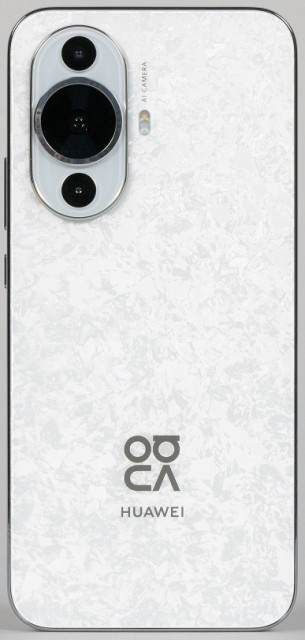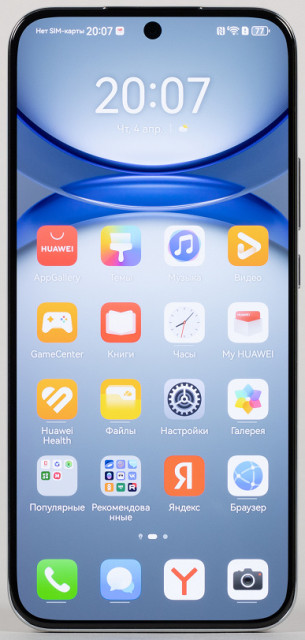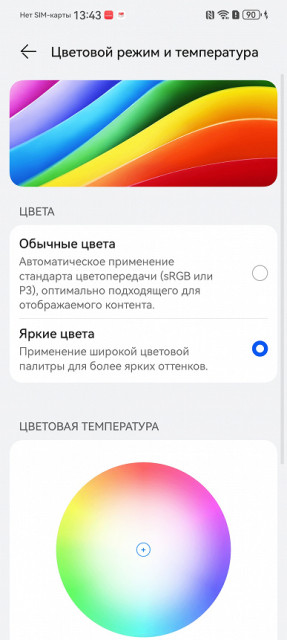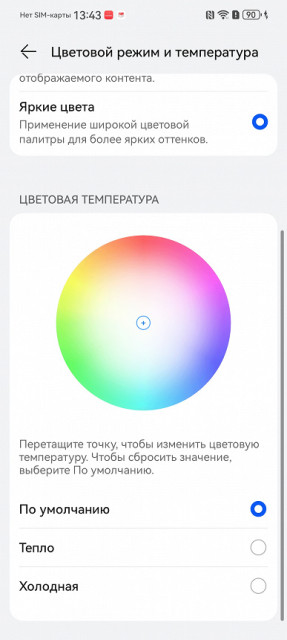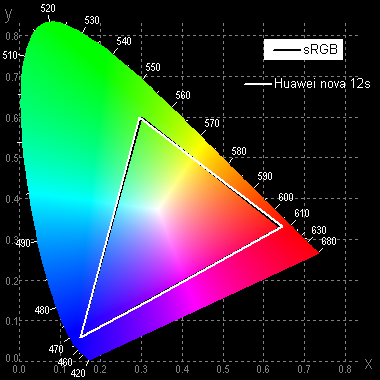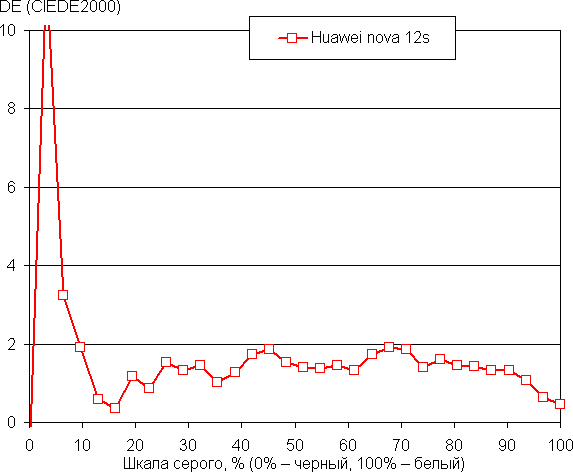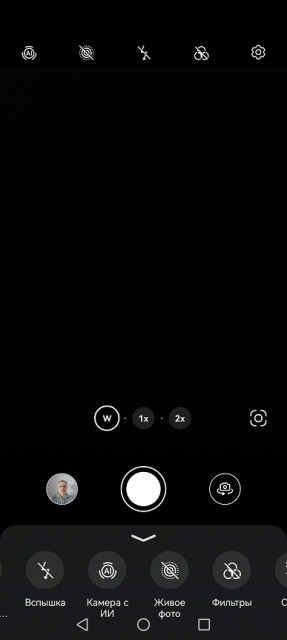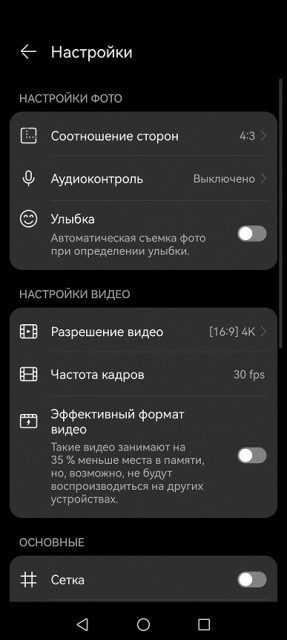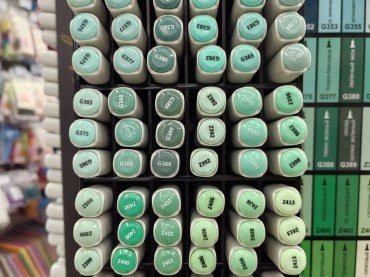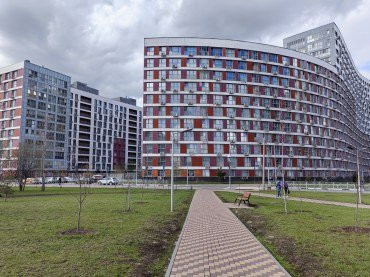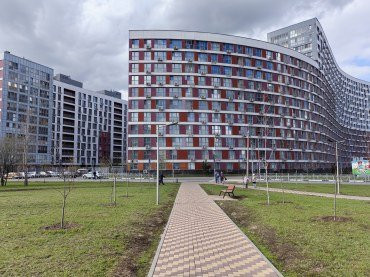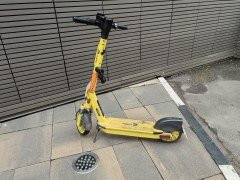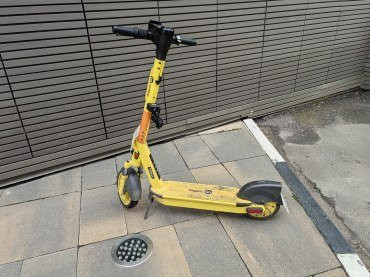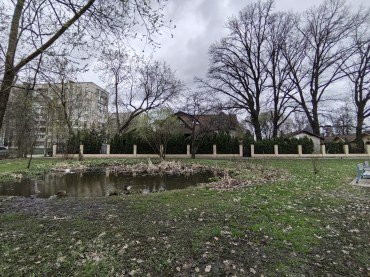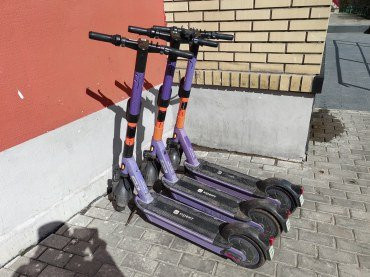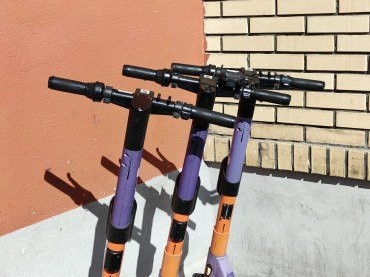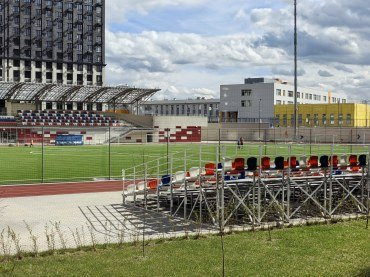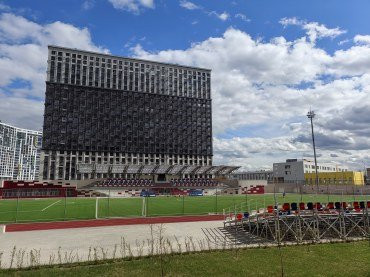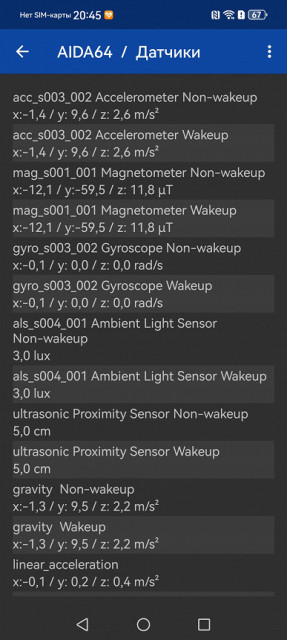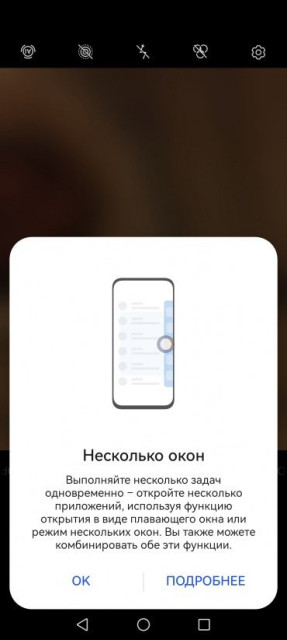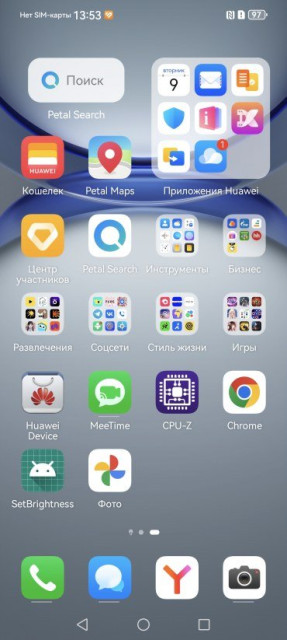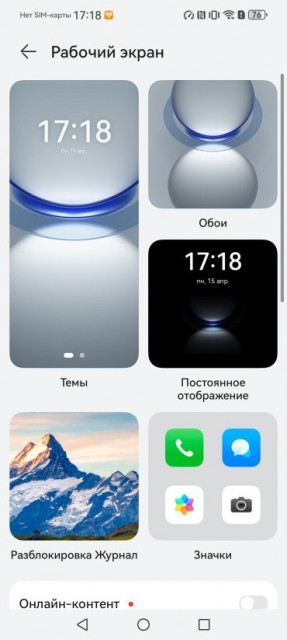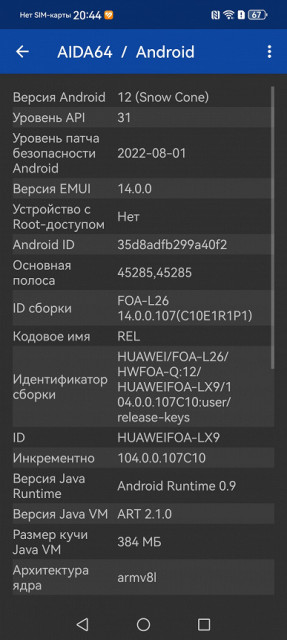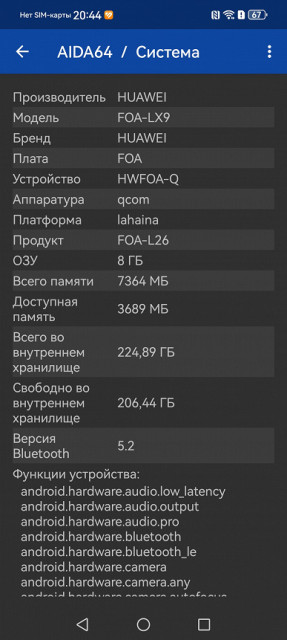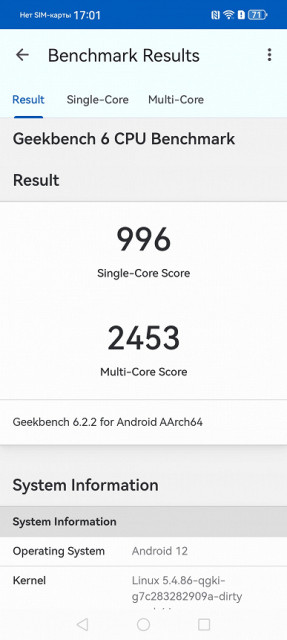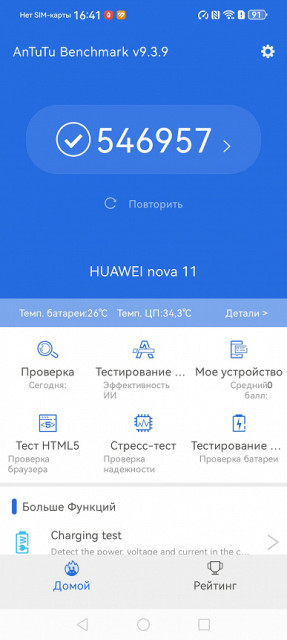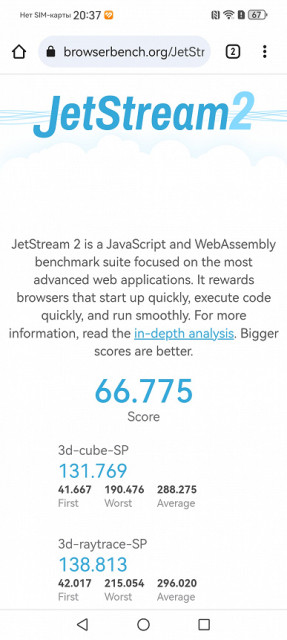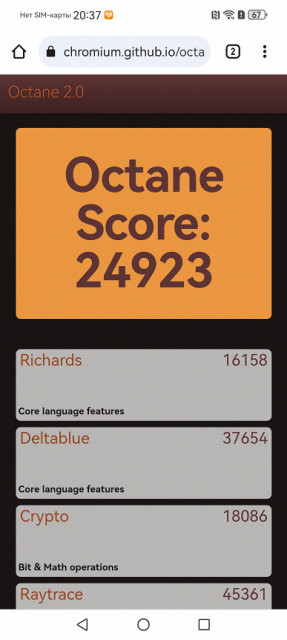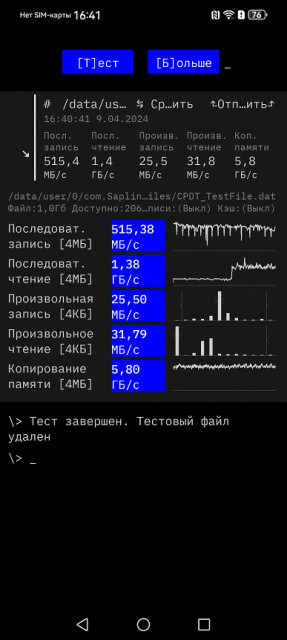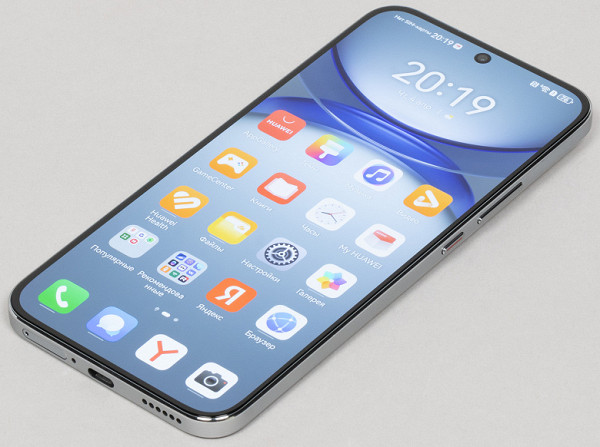
Main characteristics of Huawei nova 12s (model FOA-LX9)
- SoC Qualcomm SM7325 Snapdragon 778G 4G, 8 processor cores (4×[email protected] GHz + 4×[email protected] GHz)
- GPU Adreno 642L
- Operating system EMUI 14, without Google Play Services
- Touch display AMOLED, 6.7″, 1084×2412, 20:9, 395 ppi, 120 Hz
- RAM 8 GB, internal memory 256 GB
- No microSD support
- Nano-SIM support (2 pcs.)
- Networks 2G GSM, 3G WCDMA, 4G LTE
- GPS (L1), Glonass, BDS, Galileo and QZSS
- Wi-Fi 6 (2.4 and 5 GHz)
- Bluetooth 5.2, A2DP, LE
- NFC
- USB Type-C, USB OTG
- There is no 3.5mm audio output for headphones
- Cameras 50 MP + 8 MP (wide-angle), video 4K@30 fps
- Front camera 60 MP
- Proximity and lighting sensors, magnetic field, accelerometer, gyroscope
- Fingerprint scanner (under the screen)
- Battery 4500 mAh, charging 66 W
- Dimensions 161×75×6.9 mm
- Weight 168 g
Appearance and ease of use
The Huawei nova 12s smartphone comes in a hard cardboard package with a minimalist design.
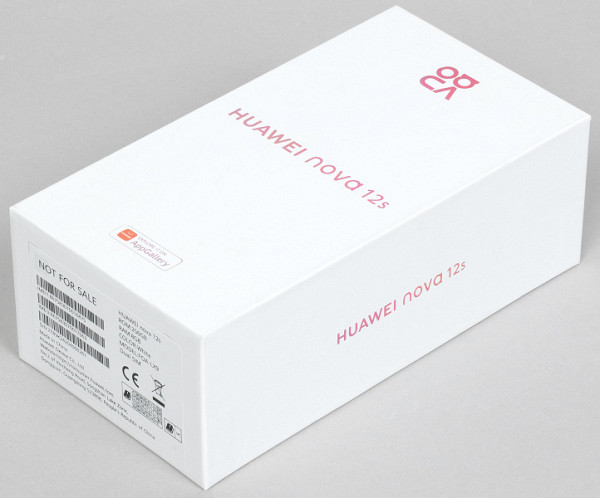
The kit includes a 66 W power supply and a connecting cable.
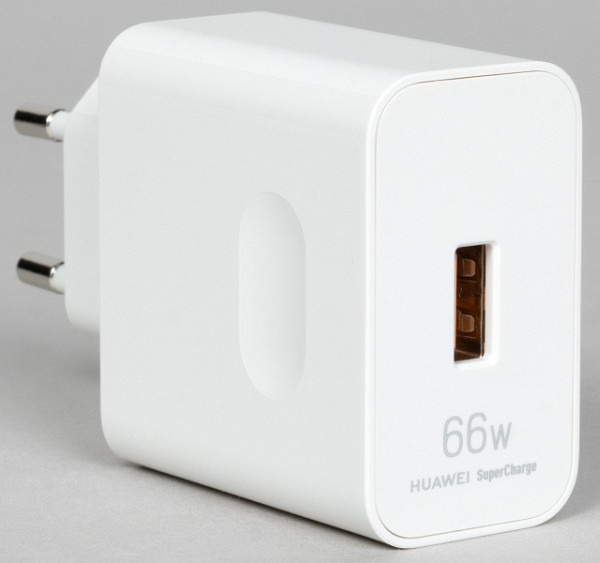
Huawei nova 12s has an attractive and neat design with ergonomic shapes. This thin and light mobile device has wide, flat side frames and smooth front and back panels without bends or narrowing. The matte surface of the frame with a slight roughness provides excellent grip on the hand, and its low weight makes it convenient to carry in any pocket.
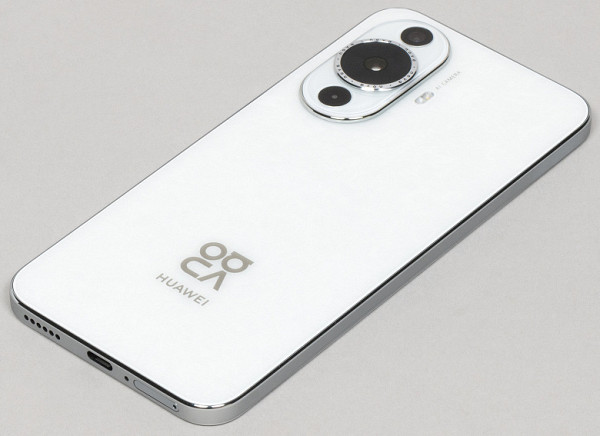
In previous models nova 11 and nova 10, the screens had a curved shape, while in Huawei nova 12s the front glass is finally flat. The factory film is no longer there. The back panel is matte and completely resistant to fingerprints. It is decorated with an interesting design in the form of “frosty patterns” that barely shine in the rays of light. The visual splendor is complemented by the uniquely designed camera array on the rear panel.
From season to season, designers continue to transform their own style of camera block design, inspired by the movement of cosmic bodies. The “orbital ring” is also retained in Huawei nova 12s. A striking metal bezel, shimmering in the light, is decorated with the inscription “nova” and surrounds the main camera lens. This stylish element complements the overall image of the device, giving it a finished look. Huawei designers have found a unique way to make their nova smartphones unique and inimitable.
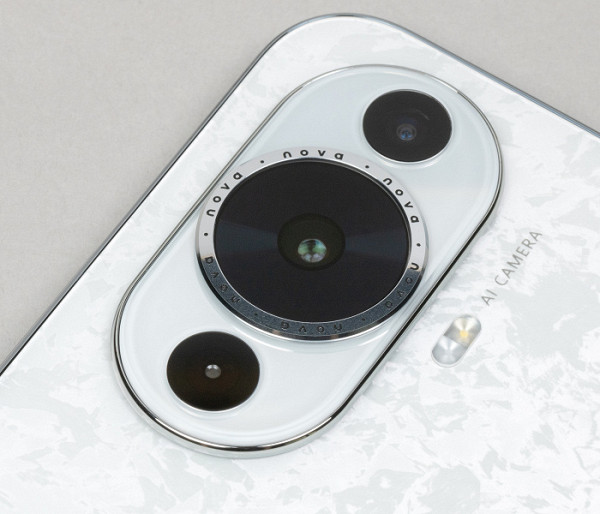
The cameras protrude from the back, so the smartphone does not lie very stable on the table. But the cameras located in the corner do not overlap with your fingers when shooting, which is much more important. Everything here is arranged correctly.

A single front camera eye is installed behind a circular cutout in the screen matrix right in the center of the top edge.

The fingerprint scanner is located under the bottom of the screen glass. It is optical and works more or less quickly, but this solution is still less convenient and fast than a scanner in the side button.
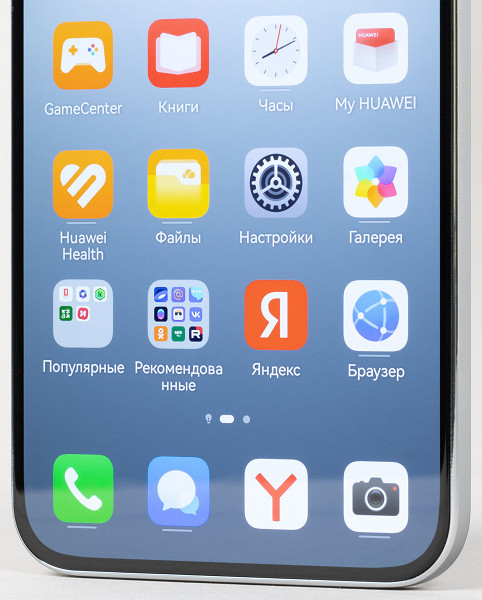
The side button, by the way, made it possible to place the scanner right here: the keys are wide, the sides themselves are also wide, there are no obstacles to this. The buttons have a stiff feel, and the power key is beautifully decorated with a red stripe in the recess.

The slot on the bottom can accommodate two Nano-SIM cards (on one side and the other side of the sled). Installing a microSD memory card is not supported.

Also at the bottom end there is a speaker, microphone and USB Type-C connector. There is no 3.5 mm wired headphone output.

The top end contains an additional microphone and a second speaker for stereo sound.

The Huawei nova 12s smartphone is available in several design options, and depending on the color, the pattern of the back wall differs slightly. The smartphone case did not receive full protection from moisture and dust.
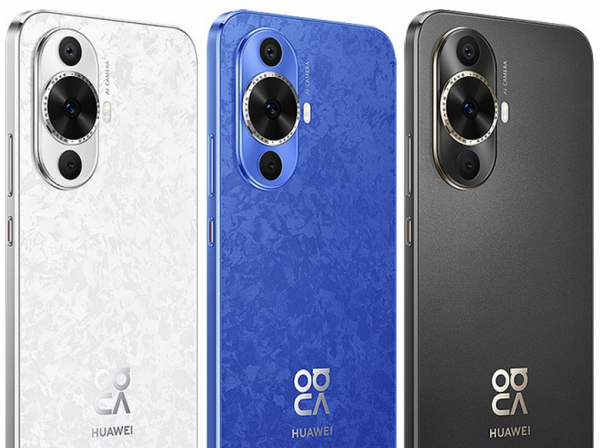
Screen
The Huawei nova 12s smartphone offers the user a 6.7-inch diagonal AMOLED display with a resolution of 1084×2412 pixels (20:9), protected by a flat protective glass. The physical screen dimensions are 70x155 mm, and the pixel density reaches 395 ppi. The frames around the screen are 2 mm wide on the sides and 3 mm wide at the top and bottom. This display supports a 120Hz refresh rate and HDR10+.
The Huawei nova 12s smartphone is a stylish device with a flat glass front surface that has a mirror-smooth surface that is scratch-resistant. This screen has excellent anti-glare properties, superior to its predecessors such as the Nexus 7. It also has an oleophobic coating that makes it more fingerprint resistant and easier to clean.
The maximum display brightness is 470 cd/m² in normal conditions and can reach 990 cd/m² in bright light. Even at a low brightness of 1.8 cd/m², the screen remains readable in complete darkness. Automatic brightness adjustment allows you to adapt the brightness to the surrounding light.
However, at high and medium brightness levels there is noticeable modulation at approximately 60 or 120 Hz.
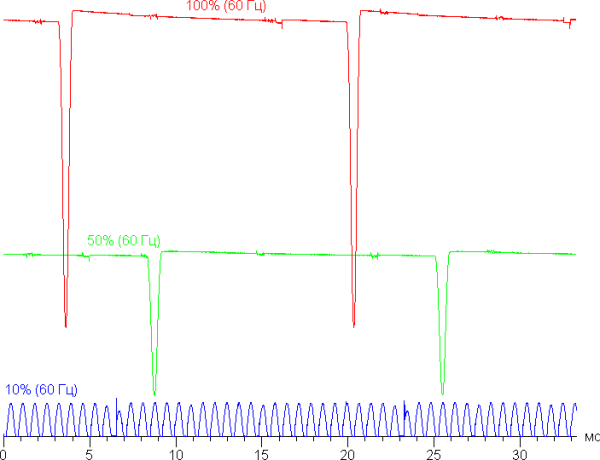
At high and medium brightness levels, the screen refresh rate remains low (60 Hz), but the modulation duty cycle is low, which prevents visible flicker. With a significant decrease in brightness, the modulation frequency increases to 1.44 kHz, but visible flicker remains absent.
In the screen settings there is an option to enable a mode with an increased refresh rate of up to 120 Hz:

In 120Hz mode, scrolling smoothness is noticeably improved. Let's see if this changes the nature of the modulation. 120Hz mode:
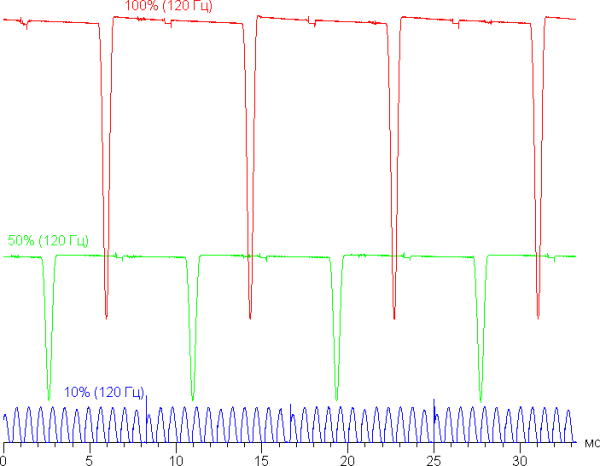
At high and medium brightness, the modulation frequency doubled, but at low brightness it remained unchanged. There is no flickering on the screen.
You can also activate the DC Dimming function. When it is turned on, only the nature of the modulation at low brightness changes, but there is also no visible flicker. Let's provide graphs for the mode with a refresh rate of 60 Hz:
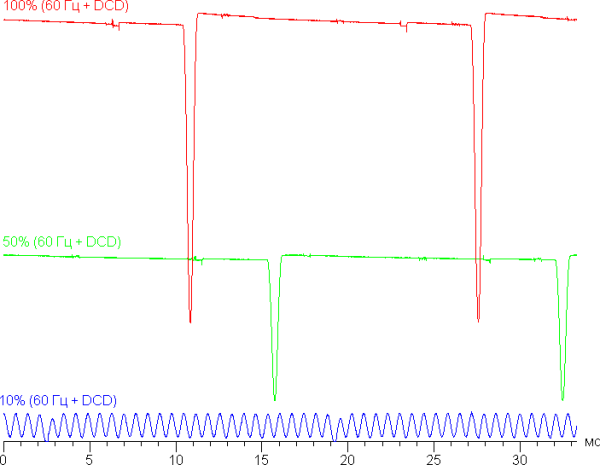
And for 120Hz refresh rate mode:

This screen uses an AMOLED matrix based on organic light-emitting diodes. The image is created using subpixels of three colors: red ®, green (G) and blue (B). However, the number of red and blue subpixels is half that, which is characterized as RGBG. This is confirmed by a fragment of a microphotograph:
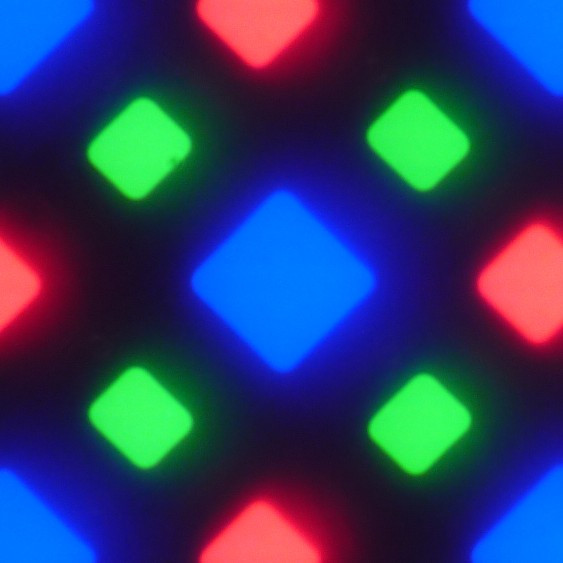
In the fragment above you can see 4 green subpixels, 2 red (4 halves) and 2 blue (1 whole and 4 quarters). By repeating these fragments, you can fill the entire screen without gaps or overlaps. For such matrices, Samsung introduced the name PenTile RGBG. The manufacturer determines the screen resolution based on green subpixels, but it will be lower for the other two colors. Although there are some artifacts such as jagged contrast edges, due to the high resolution they have minimal impact on image quality.
The screen has excellent viewing angles. However, at large angles of deflection, white can take on a subtle blue-green tint, although black remains just black at any angle. It is so saturated that the contrast parameter is not applicable in this case.
For comparison, here are photographs in which the screens of two devices display the same images. The brightness of the screens is initially set to approximately 200 cd/m², and the color balance on the camera is set to 6500 K.
White field (bright colors):

Note the good uniformity of brightness and color tone of the white field.
And a test picture (profile Normal colors):

Color reproduction is good, colors are rich, but the color balance of the screens varies slightly. However, it should be remembered that the photograph is not a reliable source of information about the quality of color reproduction and is used for illustrative purposes only. For example, the pronounced reddish tint of white and gray fields in photographs of a smartphone screen, which is visible from a certain viewing angle, is actually not as visually noticeable as it appears in the photo. This is confirmed by hardware tests using a spectrophotometer. The reason is that the spectral sensitivity of the camera matrix does not completely match the sensitivity of human vision.
The photo was taken using the «Normal Colors» profile active in the screen settings. Please note that there are only two profiles available.
The Vivid Colors profile (selected by default) differs slightly in color balance:

The brightness of both screens noticeably decreases at an angle, but on the smartphone this happens less pronounced. Consequently, at the same formal brightness, the mobile device screen appears visually brighter compared to LCD screens, especially when viewed from a slight angle.
Switching the state of the matrix elements occurs almost instantly, however, when turned on, a step with a width of about 17 ms (which corresponds to a screen refresh rate of approximately 60 Hz) or about 8 ms (120 Hz) may be noticeable. Below is the dependence of brightness on time during the transition from black to white:
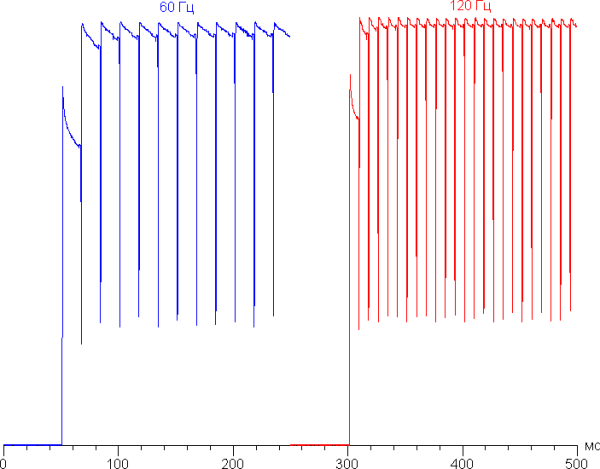
In some situations, the presence of such a step can cause the appearance of plumes that trail behind moving objects.
A gamma curve constructed using 32 points with equal intervals based on the numerical value of the gray shade showed the absence of a significant rollover in both highlights and shadows. The index of the approximating power function was 2.26, which is close to the standard value of 2.2. In this case, the real gamma curve deviates little from the power-law dependence.

Let us recall that in OLED screens the brightness of image fragments dynamically changes depending on the nature of the displayed content, decreasing slightly for light images in general. As a result, the resulting brightness versus hue relationship (gamma curve) probably does not correspond to the gamma curve of a static image, since the measurements were carried out with sequential output of shades of gray over almost the entire screen.
The color gamut for the Vivid Colors and Normal Colors profiles is close to sRGB.
The color components are mixed together to a large extent, which narrows the gamut to sRGB:

Bright colors

Regular colors
This device allows you to adjust the color balance by selecting a color temperature profile or adjusting the hue on the color wheel. However, even without correction, the Normal Colors profile provides a good balance of shades on the gray scale, thanks to a color temperature close to the standard 6500 K and a low deviation from the blackbody spectrum (ΔE less than 3 units). This indicator is considered good even for professional devices. At the same time, color temperature and ΔE practically do not change depending on the shade, which has a beneficial effect on the visual perception of color balance.
Of course, there is a function to reduce the intensity of the blue component:

The description of the Vision Protection mode contains misinformation regarding eye fatigue. Although bright light can disrupt the circadian rhythm, this effect can be reduced by reducing the brightness to a comfortable level without changing the color balance by reducing the contribution of blue light.
Apparently, this device does not support DisplayPort Alt Mode for USB Type-C — the ability to output image and sound to an external device via a USB port.
So, the screen has a high maximum brightness (990 cd/m²) and excellent anti-glare properties, which allows it to be used outdoors even on sunny days. In complete darkness, the brightness can be reduced to a comfortable level (1.8 cd/m²). The mode with automatic brightness adjustment works adequately. Other benefits include an effective oleophobic coating, no flicker, high refresh rate mode (120Hz), near sRGB color gamut and good color balance (if you select the right profile). In addition, the OLED screen provides true blacks and less drop in brightness when viewed at an angle, raising its quality to a very high level.
Camera
The Huawei nova 12s smartphone is equipped with a set of two rear cameras and one front camera.
- 50 MP, f/1.9, Laser AF, PDAF (main)
- 8 MP, f/2.2, 112˚ (wide-angle)
- 60 MP, f/2.4, 100˚ (selfie)
The main camera is equipped with advanced laser-guided phase detection autofocus, but is not equipped with an optical stabilizer. However, the device is equipped with a separate color temperature sensor that ensures accurate color reproduction. By default, photos are taken at 12.5 megapixels using the pixel binning feature. It is possible to switch to shooting in full resolution of 50 megapixels, but in this case it does not make sense, since the detail of such photos remains low.
Despite the presence of the declared color temperature sensor, the color rendition of the images differs from the natural one, especially from the point of view of a European view. They are processed to saturation, with strong colors, especially in the case of the sky, which looks as saturated as possible. However, such pictures are obtained with maximum contrast, which can be considered the calling card of this camera. Photos undergo deep processing, which removes noise, but this leads to the loss of fine details. Contour sharpening is also set to maximum, which creates clear outlines of objects, but sometimes with ghosting around them. It is noted that preserving all the details, like in flagship cameras, is not pursued here, but the result looks nice: the pictures are bright, quite clear, without blur. Detail ranges from weak to artificially high, and the dynamic range in most cases allows you to reproduce all midtone shades without overexposure. In addition, built-in color filters allow you to adjust color correction. Overall, the main camera produces images with an individual style that can be rated as decent while being average in terms of performance.
Night shots look decent. The photographs are spectacular, there are a lot of details, little noise, and the exposure is adequate. Color rendition, however, is noticeably embellished in this case as well.

The wide-angle camera, as usual, is somewhat inferior in detail to the main camera, especially in the corners of the frame, where blur can be observed. However, the quality of the images is still decent: they are quite clear, with adequate contrast, and color rendition is approximately consistent with the main camera, although not quite accurately.
The smartphone does not have a long-focus lens, the zoom is only digital, but at 2x zoom the pictures still have the right to life; they clearly use details from full-size photographs.
XD Portrait Engine algorithms are responsible for portrait functions. The front camera with a 60 MP sensor and a 100˚ viewing angle does not have autofocus and LED backlighting, but if necessary, backlighting is provided through the screen. It also uses the pixel binning feature. The shooting quality is very good: detail, elaboration of highlights, shadows and midtones, contrast and adequate color rendition do not cause any complaints. Although there is only one camera, it is capable of simulating different focal lengths using digital zoom.
When recording video, the colors appear bright and unnatural. However, the image remains clear, bright, highly detailed, without visible flicker, and the video stream is smooth and uniform. The smartphone is capable of recording video in resolutions up to 4K at 30 frames per second, and the 60 fps mode is only available in 1080p. Electronic stabilization (gyro-EIS) ensures smooth images when shooting without a tripod. The recorded sound is also of good quality, but there seems to be no wind noise suppression system.
Telephone and communications
The Huawei nova 12s smartphone has a basic set of network capabilities. Various bands of 4G mobile networks, two bands of Wi-Fi 6 and Bluetooth 5.2 are supported, and NFC support is also provided. However, there is no support for 5G and e-SIM technologies. In the urban area of Moscow and surrounding areas, the device demonstrated reliable operation in wireless networks, providing a stable connection and quick restoration of communication after a break. The built-in sensors, including the gyroscope, work properly.
The satellite navigation module supports GPS, Glonass, BDS, Galileo and QZSS. Satellites are quickly detected during a cold start, and positioning accuracy leaves much to be desired.
The sound during calls through the speaker is loud enough, providing good speech intelligibility. The vibration for an incoming call is pleasantly soft.
Software and multimedia
The Huawei nova 12s smartphone runs on its own EMUI 14 interface, based on the Android 12 operating system. The interface is enriched with many additional features and capabilities, but the home screen may seem oversaturated with pre-installed applications grouped into folders. The number of such applications is excessive. Sometimes there are unexpected advertisements, but only from Huawei’s own services. Always-On mode is well designed, offering a variety of sleep screen display options.
There is no access to the official Google Play application store and Google services. However, it is worth noting that in AppGallery’s own application store, you can find not only all the necessary applications for a long time, but also those that may not be available on Google Play.
The smartphone is equipped with stereo speakers that provide an average sound level in both volume and quality. The headphones sound better, and there is Huawei's own Histen audio effects system. The device does not have a 3.5 mm jack for wired headphones.
Performance
The Huawei nova 12s smartphone is equipped with an eight-core Qualcomm SM7325 Snapdragon 778G 4G processor, and Adreno 642L GPU is used for graphics processing. The device is equipped with 8 GB of RAM and 256 GB of internal storage. Unfortunately, the smartphone does not have a memory card slot, but it supports connecting external devices to the USB Type-C port in USB OTG mode.
This platform was announced back on May 19, 2021 and is produced according to 4 nm process standards. While it's no longer considered super-fresh or very performant by today's standards, it's fairly mid-tier and typically scores between 500 and 600 thousand points on AnTuTu. Despite this, this level of performance is quite sufficient to perform various tasks and ensure smooth operation of the interface. As for games, the smartphone copes with them, although not always at high settings. Overall, the level of this platform is quite adequate, but many users might expect a more recent SoC.
Testing in comprehensive tests AnTuTu and GeekBench:
We compiled all the results obtained when testing the smartphone in the latest versions of popular benchmarks into tables for ease of analysis. Typically, such tables also add results from other devices from different segments, which were also tested on similar versions of benchmarks. This is done in order to provide a clear comparison of the results obtained. However, due to limitations on the amount of data in a single comparison, we cannot include all valid and relevant models, as they may have been tested on previous versions of the benchmark programs.
| Huawei nova 12s (Qualcomm Snapdragon 778G) | Tecno Spark 20 Pro+ (Mediatek Helio G99 Ultimate) | OnePlus Nord 3 5G (Mediatek Dimensity 9000) | Realme 12 Pro+ (Qualcomm Snapdragon 7s Gen2) | Redmi Note 13 Pro+ (Mediatek Dimensity 7200 Ultra) | |
|---|---|---|---|---|---|
| AnTuTu (v9.x) (bigger is better) | 546957 | 387428 | 789188 | 576685 | 669583 |
| GeekBench 6 (bigger is better) | 996/2453 | 744/2019 | 1077/3175 | 894/2801 | 1126/2643 |
Testing the graphics subsystem in GFXBenchmark gaming tests:
| Huawei nova 12s (Qualcomm Snapdragon 778G) | Tecno Spark 20 Pro+ (Mediatek Helio G99 Ultimate) | OnePlus Nord 3 5G (Mediatek Dimensity 9000) | Realme 12 Pro+ (Qualcomm Snapdragon 7s Gen 2) | Redmi Note 13 Pro+ (Mediatek Dimensity 7200 Ultra) | |
|---|---|---|---|---|---|
| GFXBenchmark Aztec Ruins OpenGL (Onscreen, fps) | 34 | 16 | 96 | 35 | 50 |
| GFXBenchmark Aztec Ruins Vulkan (Onscreen, fps) | 38 | 14 | 105 | 39 | 55 |
| GFXBenchmark Car Chase ES 3.1 (1080p Offscreen, fps) | 33 | 15 | 79 | thirty | 43 |
| GFXBenchmark Manhattan ES 3.1 (1080p Offscreen, fps) | 56 | 26 | 151 | 54 | 74 |
| GFXBenchmark T-Rex (1080p Offscreen, fps) | 133 | 64 | 293 | 122 | 191 |
Testing in browser cross-platform tests:
| Huawei nova 12s (Qualcomm Snapdragon 778G) | Tecno Spark 20 Pro+ (Mediatek Helio G99 Ultimate) | OnePlus Nord 3 5G (Mediatek Dimensity 9000) | Realme 12 Pro+ (Qualcomm Snapdragon 7s Gen 2) | Redmi Note 13 Pro+ (Mediatek Dimensity 7200 Ultra) | |
|---|---|---|---|---|---|
| Google Octane 2 (bigger is better) | 24923 | 24024 | 29390 | 30529 | 39276 |
| JetStream (bigger is better) | 67 | 75 | 76 | 85 | 79 |
Memory speed test results:
Heat
We test for performance degradation when heated using the Burnout Benchmark program, which allows you to load the CPU, GPU and NPU:
| Stress on | Heating performance as a percentage of maximum |
|---|---|
| CPU | 35% |
| GPU | 67% |
| NPU | 82% |
Battery life
Despite the reduced battery capacity, the Huawei nova 12s smartphone demonstrates almost the same level of autonomy as devices with 5000 mAh batteries. The autonomy of this compact and lightweight smartphone is a positive experience.
Testing was carried out at a standard level of energy consumption without activating energy saving functions, although such capabilities are provided in the device. Test conditions included a minimum comfortable brightness level (approximately 100 cd/m²). During the tests, the following tests were carried out: continuous reading in the Moon+ Reader application (with a standard, light theme), continuous viewing of videos in HD quality (720p) and playing Injustice 2 with automatic graphics settings.
| Battery capacity | Reading mode | Video mode | 3D Game Mode | |
|---|---|---|---|---|
| Huawei nova 12s | 4500 mAh | 22:00 | 19:00 | 7:00 am |
| Vivo V30 | 5000 mAh | 23:00 | 21:00 | 8:00 am |
| Vivo V29 | 4600 mAh | 21:00 | 19:00 | 8:30 a.m. |
| Infinix GT 10 Pro | 5000 mAh | 20:30 | 18:00 | 8:30 a.m. |
| Tecno Camon 20 Pro 5G | 5000 mAh | 19:00 | 16:00 | 7:00 am |
| Vivo V27 | 4600 mAh | 25:00 | 19:00 | 7:00 am |
All these are the maximum possible figures obtained under “ideal” conditions, including without installed SIM cards. Any changes in the operating scenario will most likely lead to worse results.
The included mains charger charges the smartphone in about 40 minutes. Wireless charging is not supported.
Bottom line
Sub-flagship status, both in terms of performance and the set of communication modules, is not typical for this review hero. However, the device stands out for its thin and elegant design, high-quality camera and excellent AMOLED screen. Although the sound, battery life and network capabilities remain at the level of a typical average smartphone, overall this is a good solution for the average budget.

